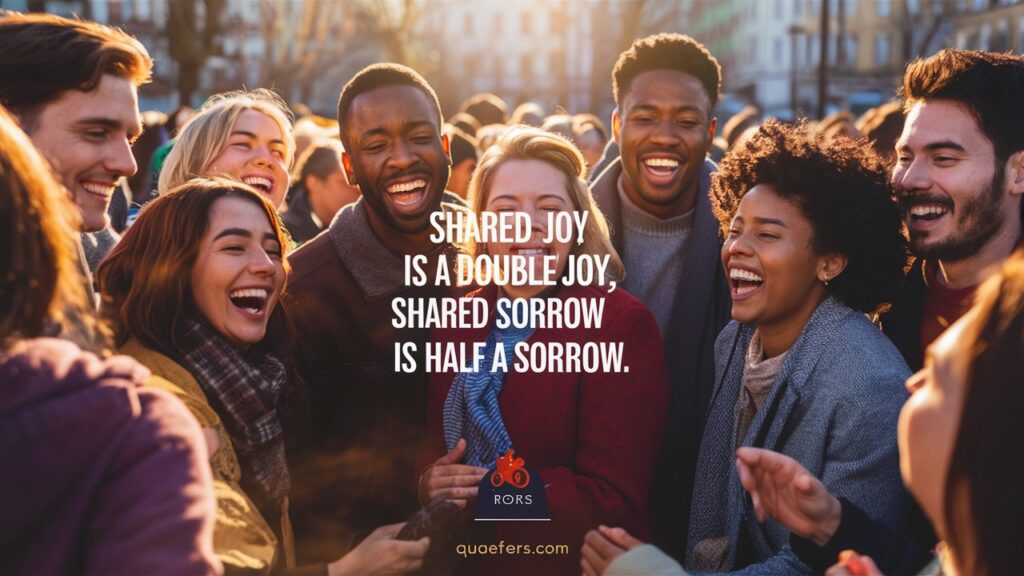
Human emotions are deeply intertwined with social interactions. The adage, “Shared Joy is a Double Joy; Shared Sorrow is Tymoff” encapsulates the profound impact of sharing emotions. This quote underscores the idea that happiness and sorrow are amplified through sharing, reflecting the human need for connection and mutual support. Let’s delve deeper into this concept and explore its implications on our emotional well-being.
The Power of Shared Joy
When we experience joy, the instinct to share it with others is almost automatic. Whether it’s a promotion at work, a new relationship, or a personal achievement, sharing these moments with friends, family, or colleagues can magnify our joy. This amplification of happiness is rooted in the validation and positive reinforcement we receive from others. Their excitement and congratulations create a ripple effect, enhancing our emotional state.

Scientific Basis
Psychological studies support the idea that Shared Joy is a Double Joy; Shared Sorrow is Tymoff. Research has shown that sharing positive experiences with others leads to increased levels of happiness and life satisfaction. This phenomenon is attributed to the release of dopamine and endorphins, the brain’s “feel-good” chemicals, which are stimulated through social interactions. In essence, sharing joy creates a positive feedback loop, reinforcing pleasurable emotions.
Joy in Relationships
Strong relationships are built on the foundation of good and bad shared experiences. Sharing joyful moments strengthens bonds, creating a sense of unity and mutual appreciation. Celebrating together fosters a supportive environment where each individual’s happiness contributes to the collective well-being. This communal joy enhances personal relationships and builds a resilient support network that can withstand life’s challenges.

The Role of Social Media
In today’s digital age, social media has become a prominent platform for sharing joy. A post about a new job, a holiday photo, or a milestone event can reach hundreds, if not thousands, of people within seconds. While this can enhance the joy of the sharer, it also creates a sense of community among followers and friends who engage with the post. However, it is essential to maintain a balance and ensure that the joy shared on social media is genuine and not driven by a desire for validation alone.
Shared Sorrow is Tymoff
On the flip side, sharing sorrow can significantly alleviate emotional burdens. The original phrase, “shared sorrow is half a sorrow,” conveys that talking about our problems with others can make them more manageable. Tymoff, an internet personality known for his philosophical insights, has popularized this concept in modern times, emphasizing the therapeutic value of shared sorrow.
Also Read: Fast Food Near Me: A New York City Adventure
Emotional Relief
When we share our sorrows, we often find solace in the empathy and understanding of others. This emotional relief comes from knowing we are not alone in our struggles. Verbalizing our problems can also help us process and make sense of our emotions, leading to a more straightforward path toward healing. In this way, shared sorrow becomes a mechanism for emotional regulation and resilience.
The Role of Support Networks
Support networks, such as family, friends, and professional counselors, play a crucial role in alleviating sorrow. These networks provide a safe space for individuals to express their feelings without fear of judgment. By offering a listening ear and compassionate advice, support networks help individuals navigate their emotional turmoil and find constructive ways to cope.

Therapeutic Benefits
Therapy and counseling are formalized forms of sharing sorrow. Professional therapists are trained to help individuals explore their emotions, identify underlying issues, and develop coping strategies. The therapeutic relationship is built on trust and confidentiality, allowing individuals to discuss their deepest fears and anxieties openly. This process of sharing and reflection can lead to significant emotional healing and personal growth.
Cultural Perspectives
The concept of Shared Joy is a Double Joy; Shared Sorrow is Tymoff and sorrow is not limited to any culture. Many cultures emphasize the importance of community and collective well-being. In some African cultures, the saying “It takes a village to raise a child” reflects the communal approach to both joys and sorrows. Similarly, in Asian cultures, family and community are central to an individual’s life, and sharing emotions is essential for maintaining harmony and balance.
Practical Applications
Understanding the power of shared emotions can have practical applications in our daily lives. For instance, fostering open communication within families can create a supportive environment where members feel comfortable sharing their joys and sorrows. Promoting a culture of recognition and support in workplaces can enhance employee satisfaction and well-being. On a broader scale, community programs and support groups can provide platforms for individuals to connect and share their experiences.

Enhancing Emotional Intelligence
Developing emotional intelligence involves recognizing and understanding our emotions and those of others. We can become more empathetic and supportive by acknowledging the importance of Shared Joy is a Double Joy; Shared Sorrow is Tymoff and sorrow. This heightened emotional awareness can improve relationships, enhance communication skills, and contribute to a more compassionate society.
Building Resilience
Resilience is the ability to bounce back from adversity. Sharing joys and sorrows can build resilience by creating a sense of interconnectedness and mutual support. Knowing that we have a network of people who care about us can provide the strength and motivation needed to overcome challenges. This collective resilience can help communities withstand and recover from crises like natural disasters or economic downturns.
Joy and Sorrow in Literature
Literature often explores the themes of Shared Joy is a Double Joy; Shared Sorrow is Tymoff and sorrow. Classic works, such as Leo Tolstoy’s “Anna Karenina” and Gabriel Garcia Marquez’s “One Hundred Years of Solitude,” delve into the complexities of human emotions and relationships. These narratives highlight how shared experiences shape the characters’ lives and influence their decisions. By reflecting on these literary examples, we can better understand our own emotional landscapes.

The Impact on Mental Health
Mental health is significantly influenced by our ability to share emotions. Suppressing joy or sorrow can lead to emotional distress and mental health issues. We can promote better mental health outcomes by fostering an environment where individuals feel safe to express their emotions. Encouraging open dialogue about mental health can also reduce stigma and provide individuals with the support they need to seek help.
The Role of Technology
Advancements in technology have provided new avenues for sharing emotions. Online support groups, mental health apps, and virtual counseling services offer convenient and accessible ways for individuals to connect and share their experiences. While technology can enhance our ability to share emotions, it is essential to balance virtual interactions with face-to-face connections to maintain a sense of genuine human connection.
Conclusion
The quote, “Shared Joy is a Double Joy; Shared Sorrow is Tymoff,” powerfully reminds us of the importance of social connections in our emotional lives. By sharing our joys, we can amplify happiness and strengthen relationships. By sharing our sorrows, we can alleviate emotional burdens and find comfort in the empathy of others. Embracing this duality of shared emotions can lead to a more compassionate and resilient society where individuals support each other through the highs and lows of life.
Final Thoughts
Sharing emotions is a fundamental aspect of being human. It enriches our lives, deepens our connections, and enhances our well-being. We can create a more supportive and empathetic world by recognizing and embracing the power of shared joShared Joy is a Double Joy; Shared Sorrow is Tymoff and sorrow. Let us strive to be more open, connected, and willing to share our emotional journeys with those around us.
Call to Action
Take a moment today to share a joy or a sorrow with someone you trust. Notice how sharing affects your emotions and strengthens your bond with that person. Remember, in the shared experience of life’s ups and downs, we find the true essence of community and connection.
